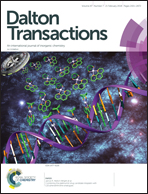Could new U(ii) complexes be accessible via tuning hybrid heterocalix[4]arene? A theoretical study of redox and structural properties†
Abstract
Tuning the building blocks of pyrrole and arene/pyridine in hybrid heterocalix[4]arene allows for the possible accessibility of several intriguing divalent uranium complexes, which are energetically stabilized by enhanced δ(U–Ar) bonds and further corroborated by computed UIII/II reduction potentials.
![Graphical abstract: Could new U(ii) complexes be accessible via tuning hybrid heterocalix[4]arene? A theoretical study of redox and structural properties](/en/Image/Get?imageInfo.ImageType=GA&imageInfo.ImageIdentifier.ManuscriptID=C7DT04557C&imageInfo.ImageIdentifier.Year=2018)


 Please wait while we load your content...
Please wait while we load your content...